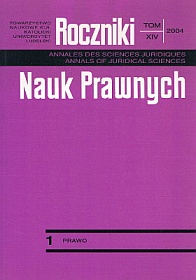Shortcominegs in the Jurisprudential Construction of the Curopean Constitution as Prerequisites for Applying in contra legem
Abstract
The project of the European Constitution that is formally entitled Treaty Establishing a Constitution for Europe, according to the Declaration of Leaken, as a juristic act was supposed to secure democracy and transparency, simplify the norms and ensure effectiveness for the Union, bringing it closer to the citizens. The name of the treaty wrongly suggests that it concerns all the citizens and countries in Europe, although it only concerns the European Union. The project is a compound juristic act. It consists of four loosely connected parts: Basic Provisions, Chart of the Fundamental Rights, Policies and Functioning of the Union and General and Final Regulations. However, the regulations contained in them are neither consistent (many regulations are doubled and their contents are contrary), nor complete, and hence they do not form a system, although the Constitution abolishes the communal legal output (acquis) and establishes a new order. It also liquidates the division into three pillars and establishes a new Union and its institutions. No regulations biding till now are included de iure directly in the new system of the Union law. With abolition of the old norms and lack of new detailed solutions (and with the weakness of the jurisprudential construction), the regulations in the Constitution silently assume a (necessary for the system to function) continuation of the old structures, mechanisms, principles, regulations and interpretations of judicial decisions. However, this is acting contra legem, and more precisely – it is anti-constitutional. Despite the disputes that were led, neither the member countries nor institutions of WE/EU paid any attention to it.
References
Arnold R.: Perspektywy prawne powstania konstytucji europejskiej, PiP 7/2000.
Biernat T.: Wspólnota prawa. O osobliwościach systemu europejskiego, Toruń 2002.
Galster J., Mik C., op. cit., s. 166 i n.,
Grant Ch., Keohen D., op. cit..
Grevi G.: An Integrated Presidency for a European Union, „The Europe We Need”, Working Paper, The European Policy Centre, 4.12.2002.
Jasiński F.: Nabycie mocy prawnie wiążącej przez Kartę Praw Podstawowych. Kilka uwag teoretycznych, PPE, nr 1, 2003, s.8 n.;
Klabbers J.: Re-inventing the law of treaties; the contribution of the EC Courts, NYIL 1999, No 300, s. 48 n.
Konwent Europejski „faza słuchania”. Wybór dokumentów, „Monitor Integracji Europejskiej”, 56/2002, s. 7 n.
Mahony H.: Franco-German contribution to the European Convention on the institutional structure of the Union, Paris−Berlin, 15.01.2003.
Mahony H.: Franco-German plan sparks mixed reaction in Europe, „EUobserver”, 10.12.2002.
Mik C., op. cit., s. 129 i n.
Mik C.: Europejskie prawo wspólnotowe. Zagadnienia teorii i praktyki, t. I, Warszawa 2000.
Mik C.: Prawo międzynarodowe. Materiały, s. 386.
Parzymies S.: Reformy instytucjonalne Unii Europejskiej w Traktacie z Nicei, SM 2000, nr 4 s. 5-26.
Rome Declaration of the Convention’s Chairman V. Giscard d’Estaing, 18.07.2003.
Symonides J.,Symonides M.: La Charte des droits fondamentaux, „Relation Internationales. Stosunki Międzynarodowe” (wyd. specjalne), czerwiec 2002, s. 112 n.
Symonides J.: Unia Europejska – państwo – region, nowe pojmowanie subsydiarności i suwerenności, w: Unia Europejska. Nowy typ wspólnoty międzynarodowej, red. E. Haliżak, S. Parzymies, Warszawa 2002, s. 49-57.
Treaty establishing a Constitution for Europe, Conv. 850/03. Por też: Conv 820/1/03 Rev1; Conv 820/03: Conv 847/03; Conv 848/03.
Wyrozumska A.: Prawa podmiotowe w Unii Europejskiej, [w:] Prawo Unii Europejskiej. Zagadnienia systemowe, red. J. Barcz, Warszawa 2002, s. 344 n.
Copyright (c) 2004 Roczniki Nauk Prawnych

This work is licensed under a Creative Commons Attribution-NonCommercial-NoDerivatives 4.0 International License.


